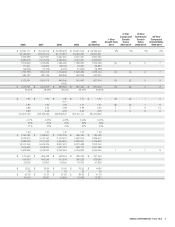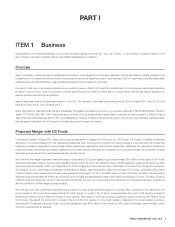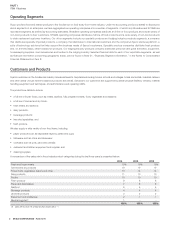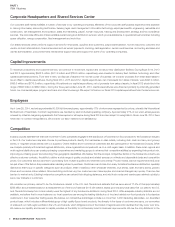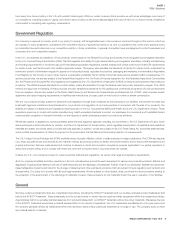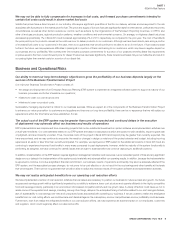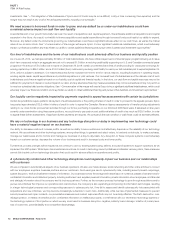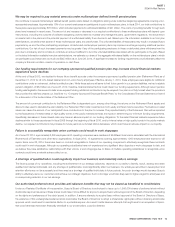Sysco 2014 Annual Report Download - page 19
Download and view the complete annual report
Please find page 19 of the 2014 Sysco annual report below. You can navigate through the pages in the report by either clicking on the pages listed below, or by using the keyword search tool below to find specific information within the annual report.SYSCO CORPORATION-Form10-K 7
PARTI
ITEM1ARisk Factors
consequences. Our business may be negatively impacted by our management having focused its attention on acquiring US Foods instead of pursuing
other advantageous business opportunities or plans. Furthermore, we will incur substantial expenses and costs related to the merger, whether or not it is
consummated, including legal, accounting and advisory fees. Also, failure to consummate the merger may result in negative market reactions, and may
have an adverse impact on Sysco’s stock price and future nancial results.
Business uncertainties during the pendency of the proposed merger may adversely impact our current business
operations and relationships with employees, vendors and customers
Prospective suppliers, customers or other third parties may delay or decline to enter into agreements with us as a result of the uncertainties surrounding the
proposed merger, and we may also lose current suppliers and customers as a result of these uncertainties. Furthermore, uncertainties as to the effect of the
merger transaction may adversely impact employee morale, and impede our ability to retain key employees. The loss of key employees or union-related work
stoppages could impact our ability to successfully integrate the businesses of Sysco and US Foods and fully realize the anticipated bene ts of the merger.
The pending merger and our current pre-merger integration planning efforts may divert resources from Sysco’s
day-to-day operations and ongoing efforts related to other strategies and initiatives
The pending merger and our current pre-merger integration planning efforts may divert our management’s attention from day-to-day business operations
and the execution and pursuit of strategic plans and initiatives, including the initiatives related to our Business Transformation Project, which has and will
continue to require a substantial amount of resources. The diversion of management attention from ongoing business operations and strategic efforts could
result in performance shortfalls, which could adversely impact Sysco’s business and operations.
The integration of the businesses of Sysco and US Foods may be more dif cult, costly or time consuming than
expected, and the merger may not result in any or all of the anticipated bene ts, including cost synergies
The success of the merger between Sysco and US Foods, including the realization of the anticipated bene ts, will depend, in part, on the ability of Sysco,
as the combined company, to successfully integrate the businesses of Sysco and US Foods. Failure to effectively integrate the businesses could adversely
impact the expected bene ts of the merger, including cost synergies stemming from supply chain ef ciencies, merchandising activities and overlapping
general and administrative functions.
The integration of two large independent companies will be complex, and we will be required to devote signi cant management attention and incur substantial
costs to integrate Sysco’s and US Foods’ business practices, policies, cultures and operations. This diversion of our management’s attention from day-to-day
business operations and the execution and pursuit of strategic plans and initiatives, including the initiatives related to our Business Transformation Project,
could result in performance shortfalls, which could adversely impact the combined company’s business, operations and nancial results. The integration
process could also result in the loss of key employees, which could adversely impact the combined company’s future nancial results.
Furthermore, during the integration planning process and after the closing of the merger, we may encounter additional challenges and dif culties, including
those related to, without limitation, managing a larger combined company; streamlining supply chains, consolidating corporate and administrative
infrastructures and eliminating overlapping operations; retaining our existing vendors and customers; unanticipated issues in integrating information technology,
communications and other systems; and unforeseen and unexpected liabilities related to the merger or US Foods’ business. Delays encountered in the
integration could adversely impact the business, nancial condition and operations of the combined company.
We may not be able to retain some of US Foods’ vendors and customers after the proposed merger, which could
negatively impact the anticipated bene ts of the merger
US Foods’ vendors or customers may have termination rights that are triggered upon completion of the merger, and such vendors or customers may
decide to not renew their existing relationship with us, and may instead select one of our competitors. If we are unable to retain and maintain these vendor
and customer relationships, then the business, nancial condition and operations of Sysco, as the combined company, could be adversely impacted.
Consummation of the merger will require Sysco to incur signi cant additional indebtedness, which could adversely
impact our nancial condition and may hinder our ability to obtain additional nancing and pursue other business and
investment opportunities
In connection with the merger, Sysco will assume or re nance all of US Foods’ outstanding debt, which was approximately $4.8 billion, as of June 28,
2014. Any re nancing of US Foods’ indebtedness is expected to be nanced with a combination of new debt and cash on Sysco’s balance sheet. Sysco
has secured fully committed bridge nancing.
Incurrence of additional indebtedness could have negative consequences, including increasing our vulnerability to adverse economic and industry conditions,
and limiting our ability to obtain additional nancing and implement and pursue strategic initiatives and opportunities. Additionally, if we do not achieve the
expected bene ts and cost savings from the merger with US Foods, or if the nancial performance of Sysco, as the combined company, does not meet
current expectations, then our ability to service the debt will be adversely impacted. Our credit ratings may also be impacted as a result of the incurrence
of additional acquisition-related indebtedness. Currently, certain credit rating agencies have put us on watch for a potential downgrade.


